Akai
Akai (Japanese: 赤井, pronounced [a̠ka̠i]) was a Japanese consumer electronics brand. The company, Akai Electric Company Ltd, was founded in 1946 in Tokyo, Japan, and defunct in 2002. Grande Holdings in Hong Kong took over Akai's Brand, now it is distributing various electronics products such as LED TV, washing machines, air conditioners and smart phones, collaborated with other electronics companies. On the other hand, inMusic Brands in United States also took over Akai's Brand. It began Akai Professional brand, and is distributing high-end audio electronics products.
 | |
| Manufacturer | |
| Industry | Electronics |
| Founded | as Akai Electric Company Ltd, Tokyo, Japan (1946) |
| Headquarters | Japan |
| Products | Hi-fi equipment |
| Parent | Grande Holdings (1999–present) inMusic Brands (Akai Professional) |
| Website | www.akai.com www.akaipro.com |
Corporate history
Akai was founded by Masukichi Akai and his son, Saburo Akai (who died in 1973[1]) as Akai Electric Company Ltd. (赤井電機株式会社, Akai Denki Kabushiki Kaisha), a Japanese manufacturer in 1929[1][2][3] or 1946.[note 1]
The company's business eventually became troubled and it left the audio industry in 1991. At its peak in the late 1990s, Akai Holdings employed 100,000 workers and had annual sales of HK$40 billion (US$5.2 billion). The company filed for insolvency in November 2000, owing creditors US$1.1B.[4] It emerged that ownership of Akai Holdings had somehow passed in 1999 to Grande Holdings, a company founded by Akai's chairman James Ting. The liquidators claimed that Ting had stolen over US$800m from the company with the assistance of accountants Ernst & Young who had tampered with audit documents going back to 1994.[5] Ting was imprisoned for false accounting in 2005,[5] and E&Y paid $200m to settle the negligence case out of court in September 2009.[6] In a separate lawsuit, a former E&Y partner, Christopher Ho, made a "substantial payment" to Akai creditors in his role as chairman of Grande Holdings.[4]
History
Historical products
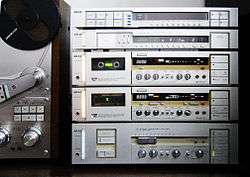
Akai's products included reel-to-reel audiotape recorders (such as the GX series), tuners (top level AT, mid level TR and TT series), audio cassette decks (top level GX and TFL, mid level TC, HX and CS series), amplifiers (AM and TA series), microphones, receivers, turntables, video recorders and loudspeakers.
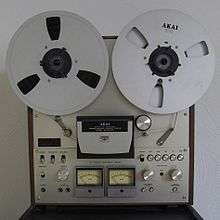
Many Akai products were sold under the name Roberts in the US, as well as A&D in Japan (from 1987 after a partnership with Mitsubishi Electric), Tensai and Transonic Strato in Western Europe. During the late 1960s, Akai adopted Tandberg's cross-field recording technologies (using an extra tape head) to enhance high frequency recording and switched to the increasingly reliable Glass and crystal (X'tal) (GX) ferrite heads a few years later. The company's most popular products were the GX-630D, GX-635D, GX-747/GX-747DBX and GX-77 open-reel recorders (latter featuring an auto-loading function), the three-head, closed-loop GX-F95, GX-90, GX-F91, GX-R99 cassette decks, and the AM-U61, AM-U7 and AM-93 stereo amplifiers.
Akai manufactured and badged most of its imported hi-fi products with the Tensai brand (named after the Swiss audio and electronics distributor Tensai International). Tensai International was Akai's exclusive distributor for the Swiss and Western European markets until 1988.
Akai limited its consumer hi-fi product line in the United States and Europe towards the end of the 20th century.
Introduction of the on-screen display
Akai produced consumer video cassette recorders (VCR) during the 1980s. The Akai VS-2 was the first VCR with an on-screen display,[7] originally named the Interactive Monitor System. By displaying the information directly on the television screen, this innovation eliminated the need for the user to be physically near the VCR to program recording, read the tape counter, or perform other common features. Within a few years, all competing manufacturers had adopted on-screen display technology in their own products.
Akai Professional
In 1984,[8] a new division of the company[9] was formed to focus on the manufacture and sale of electronic instruments, and was called Akai Professional.
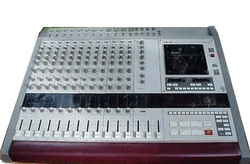
The first product released by the new subsidiary was the MG1212, a 12 channel, 12 track recorder.[10] This innovative device used a special VHS-like cartridge (a MK-20), and was good for 10 minutes of continuous 12 track recording (19 cm per second) or 20 minutes at half speed (9.5 cm per second). One track (14) was permanently dedicated to recording absolute time, and another one for synchronization such as SMPTE or MTC. Each channel strip included dbx type-1 noise reduction and semi-parametric equalizers (with fixed bandwidths). The unit also had innovations like an electronic 2 bus system, a 12 stereo channel patch bay and auto punch in and out, among others. The unique transport design and noise reduction gave these units a recording quality rivaling that of more expensive 16 track machines using 1" tape. The MG-1212 was later replaced by the MG-1214, which improved the transport mechanism and overall performance.
AX series analog synthesizers

Other early products included the Akai AX80 8-voice analog synthesizer in 1984,[10] followed by AX60 and AX73 6-voice analog synthesizers ca.1986.[11][12] The AX-60 borrowed many ideas from the Roland Juno series, but used voltage controlled analog oscillators (VCO) as a sound source as opposed to Roland's more common digitally controlled analog oscillators (DCO), and also allowed the performer to "split" the keyboard (using different timbres for different ranges of keys). The AX-60 also had the ability to interface with Akai's early samplers through a serial cable, using 12-bit samples as an additional oscillator.[13]
S series digital samplers

The S612 12-bit digital sampler in 1985, was the first in a series of (relatively) affordable samplers already in 19-inch studio-rack format but in black color.[10] It held only a single sample at a time, which was loaded into memory via a separate disk drive utilizing Quick Disk 2.8-inch floppy disks. The maximum sample time at the highest quality sampling rate (32 kHz) was one second.

The introduction of a "professional" range of digital samplers began with the 12-bit S900 in 1986,[10] followed by the X7000 keyboard sampler in 1986,[14] and the S700 rack-mount version in 1987.[10] Unlike the single-sample S612, however, they allowed the use of six active samples at once, had a built-in disk drive and could be extended with six individual outputs via cable and a flash memory extension which added another six samples to the memory for multisample playback. The S700/X7000 sampler series were light-grey colored, which didn't change throughout the whole "professional" range of Akai samplers.
The 16-bit Akai S1000 series followed in 1988, adding the option to read CD-ROMs and write to hard disks via SCSI. This range was superseded by the S3000 series in 1993, with optional built-in CD-ROM drive, followed by the S5000 and S6000. Additional releases of note were the Z4 and Z8 24-bit 96 kHz samplers.[10]
MPC
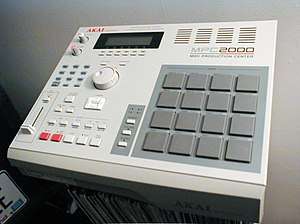
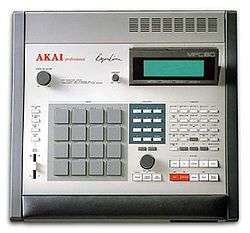
Akai also produced several Digital MIDI sequencers and digital synthesizers such as the MPC range, a line of integrated drum machines, MIDI sequencers, samplers and direct-to-disk recorders.
New ownership of Akai Professional
In December 1999, one year before the application of Civil Rehabilitation Act to Akai Electric Company Ltd., the brand of its musical instrument division, Akai Professional was acquired by a company of the United States. The new company was dubbed "Akai Professional Musical Instrument Corporation".[8] (AKAI professional M.I.) was established in the same year, however it was bankrupted in 2005.[9]
In 2004, following a US distribution deal, the Akai Professional Musical Instrument division was acquired by Jack O'Donnell, owner of Numark Industries and Alesis. In 2012, inMusic Brands was formed as a parent company for O'Donnell's companies, including Akai Professional.
An Akai Professional product that is somewhat sought after in current times is the model DM13 microphone. This small, unidirectional unit was originally made for tape recorders, as well as CB radio equipment. Today, they can be found in the arsenal of many blues harmonica players due to its high gain and high impedance properties.
Current products
In early 2003, Grande Holdings began undergoing a re-exposure Akai's brands by marketing various audio visual products manufactured by Samsung. In the same year, Grande began to distribute Akai home appliances such as air conditioners, vacuum cleaners, and refrigerators. In 2010s, it began to distribute Akai smart phones collaborated with some Chinese smart phone manufacturers (Gionee, etc.), in India and some other countries.
Video
- AV receivers
- Portable DVD players
- DVD players
- DVD recorders
- Home theatre systems
- Home theatre Speakers
- VCD players
- VCRs
Mobile sound
- Amplifiers
- Cassette receivers
- CD changers
- CD receivers
- DVD changers
- DVD receivers
- Car Audio – DVD players
- Car Audio – Speakers
- Car Audio – TFT monitors
Home appliances
- Air conditioners
- Air coolers
- Air purifiers
- Chest freezers
- Dishwashers
- Heaters
- Ice makers
- Microwave ovens
- Refrigerators
- Showcases
- Vacuum cleaners
- Washing machines
- Water dispensers
- Wine cellars
Audio
- Stereo rack systems
- Mini systems
- Micro music [15]
- Retro radios
- Sound boxes
- Portable music players
- Tape Decks
- Portable DAT Recorder/Player (Blue colored body,Webshop DirectOrder only, OEM from JVC/Victor)
- Portable MD Recorder/Player (Blue color Body,Webshop DirectOrder only, OEM from JVC/Victor)
Television
- Color televisions
- LCD televisions
- Plasma television
- Set-top boxes
Akai Professional products

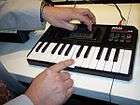
Akai Professional is not affiliated with Akai (a consumer audio and television brand). Akai Professional changed ownership in 2004 and is an inMusic Brands company, based in Rhode Island, United States.
Synthesizers
- AX60 (c.1986) – discontinued
- AX73 (c.1986) – discontinued
- AX80 (1984) – discontinued
- VX90 (c.1986) – rack-mount version of AX73, discontinued
- VX600 (c.1988) – 3-octave keyboard synthesizer with EWI connection jack, discontinued
- Akai SG01v (c.1996) – desktop sound module,[16] discontinued
- MINIAK[17] – discontinued
]][18] (1985) – discontinued
- S900[19] (1986) – discontinued
- X3700 (c.1986) – discontinued
- X7000[20] (c.1986) – discontinued
- S700[21] (1987) – discontinued
- S950[22] – discontinued
- S1000 (1988)[23] – discontinued
- S1100[24] (1990) – discontinued
- S01[25] (1992) – discontinued
- S2800[26] (1992) – discontinued
- S3000[26] (1992) – discontinued
- S3200 (1992) – discontinued
- CD3000[27] (1993) – discontinued
- REMIX16 (1995) – table-top phrase sampler, discontinued
- S2000 (1995)[28] – discontinued
- S3000XL (1995) – discontinued
- S3200XL – discontinued
- S20 (c.1997)[29] – discontinued
- CD3000XL (c.1997)[30] – discontinued
- S5000 (c.1999)[31] – discontinued
- S6000 (c.1999)[31] – discontinued
- Z4[32] (2002) – discontinued
- Z8[32] (2002) – discontinued
- MPX8
- MPX16[33]
Music Production Center
- MPC60 (1987) – MIDI Production Centre,[34] discontinued
- MPC60II – (1991) – discontinued
- MPC3000 (1993) – discontinued
- MPC3000LE (1999) – discontinued
- MPC2000[35] (1997) – discontinued
- MPC2000XL (2000) – discontinued
- MPC4000 (2002)[36] – discontinued
- MPC1000 (2003) – discontinued
- MPC500[37] (2006) – discontinued
- MPC2500[38] (2005) – discontinued
- MPC5000[39][40] (2008) – discontinued
- MPC Renaissance[41] (2012) – discontinued
- MPC Studio[42] (2012) – Discontinued
- MPC Element (2013) – Discontinued
- MPC Touch[43] (2015)
- MPC Studio Black (2016)
- MPC Live[44] (2017)
- MPC X[45] (2017)
- MPC One (2020)
- MPC Live ll (2020)
Computer audio interfaces
- EIE (2011)
- EIE PRO[46] (2011)
Drum machines
- MR16 (c.1985)
- XE-8 1U rack mounted,[47][48] Acoustic drum sound from S-1000 library, discontinued
- XR10,[49] discontinued Table Top Playback Sampler incl XE-8 Sound with Dance Sample Sounds 16-bit, discontinued
- XR20[50] (2008) Made by Alesis
- Rhythm Wolf (c.2015) Tabletop analogue drum machine with bass synth[51]
- Tom Cat
Electronic wind instruments
Effects units / Utilities
- EX90R – Reverb,[53] discontinued
- ME10D – MIDI digital delay,[54] discontinued
- ME15F – MIDI dynamic controller,[54] discontinued
- ME20A – MIDI sequencer arpeggiator,[54] discontinued
- ME25S – MIDI note separator,[55] discontinued
- ME30P – MIDI 4×8 patchbay,[55][56] discontinued
- ME35T – Audio/MIDI trigger, discontinued
- ME80P – MIDI 8×10 patchbay, discontinued
- MB76 – Programmable mix bay,[57] discontinued
- PEQ6 – Programmable equaliser,[57] discontinued
- DP88 (1993) – digital audio patchbay, discontinued
- AR900 (1986–89) – 16-bit MIDI Digital Reverb, discontinued
- MFC42 (2001) – filter bank, discontinued
- HV10 Harmony generator (2002)
- VST Plug-ins (2002)
Guitar pedals
- Analog Delay
- Blues Overdrive
- Chorus
- Compressor
- Deluxe Distortion
- Drive3 Distortion
- Drive3 Fuzz
- Drive3 Overdrive
- E2 Head Rush
- Flanger
- Phase Shifter
iPod/iPad Keyboard Controllers
- SynthStation25
- SynthStation49
- AkaiMPC Fly (2012)
MIDI Sequencers
- MS08 (c.1985) – discontinued
- ASQ10[58] (c.1986/7) – discontinued
Standalone Multi-track Audio Recorders
- MG1212 (1984) – discontinued
- MG1214 (c.1985) – discontinued
- DR1200/DL1200 (1988) – discontinued
- DD1000 (1990) – discontinued
- DD/DL1500 (1994) – 16-track DAW, discontinued
- DD8 (1996) – discontinued
- DD8plus (1998) – discontinued
- DR4D (1993) – discontinued
- DR8 (1994) – discontinued
- DR16 (1995) – discontinued
- DPS12[59] (1997) – discontinued
- DPS16 (1999) – discontinued
- DPS24 (2002)[60] – discontinued
- DPS24MKII – discontinued
- RE32 (1999) – controller for DD/DR series, discontinued
Studio Monitor Speakers
- RPM3
- RPM8 – discontinued
- 50x
USB MIDI / MIDI controllers
- APC20[61]
- APC40[62]
- APC40 MkII[63]
- EWI-USB
- LPD8 (2009)[64]
- LPK25 (2009)[64]
- MPD16 (2002) – discontinued
- MPD18 – discontinued
- MPD24[65] (2006) – discontinued
- MPD26 (2010)
- MPD32 (2008)
- MPK25[66] (2009)
- MPK49[67] (2007)
- MPK49 V2 (2007)
- MPK61 (2009)
- MPK88 (2009)
- MPKMINI[68]
- Akai MPKMINI MK II (2014)
- MPKMINI MK III (2020)
- MPK225 (2014)
- MPK249 (2014)
- MPK261 (2014)
- MAX25 (2014)
- MAX49[69] (2014)
- MX73 MIDI Master Keyboard[70] – discontinued
- MX76 MIDI Master Keyboard[71] (1987) – discontinued
See also
- 1/4-inch Akai VTRs
- Akai VK (videocassette format) VTRs
- List of phonograph manufacturers
Notes
- Although reliable sources are not yet found, according to the several sources (kotobank.jp, ja:Akai Professional), Masukichi Akai established Akai Press Industry in 1923, then his son, Saburo Akai established Akai Electric Company Ltd. in 1946, and Masukichi served as the president of both.
References
- "Akai Electric Company Ltd". Reel to Reel Tape Recorder Manufacturers. Museum of Magnetic Sound Recording. Retrieved 2013-07-02.
- "About Akai". akai.com. Akai. Retrieved 2013-07-02.
- "Akai History". adt-digital.com. Akai. Archived from the original on 2013-08-10. Retrieved 2013-07-02.
- Duce, John; Tan, Andrea (2009-10-05). "Akai Liquidator to Receive Payment in Settlement With Grande". Bloomberg. Archived from the original on 2014-02-22.
- Rovnick, Naomi; Lo, Clifford (2009-09-30). "Raids, arrest as fraud police probe Akai files". South China Morning Post.
- Rovnick, Naomi (2010-01-27). "Ernst & Young pays up to settle negligence claim". South China Morning Post.
- "Stylish Akai VS-2 appeal". The Sydney Morning Herald. 1983-04-24.
-
"Akai Professional / Akai Digital – Company History". AKAI professional M.I. Corp. c. 1999. Archived from the original on 2013-05-03.
Akai Professional entered the electronic musical instrument world in 1984 with one purpose – to give artists the tools they need to express and explore new musical ideas.”, “In 1999, Akai Professional Musical Instruments Corporation (APMI) was formed.
-
アカイプロフェッショナルエムアイが破産手続き開始 [Akai Professional M.I. entered bankrupt proceedings.]. 神奈川新聞 (in Japanese). 2005-12-07. Archived from the original on 2006-01-12.
民間信用調査会社の帝国データバンク横浜支店によると、音響機器製造のアカイプロフェッショナルエムアイ(横浜市都筑区北山田、駿河道生社長、従業員十七人)は七日までに、東京地裁から破産手続き開始決定を受けた。... 同社は一九九九年十二月、赤井電機(東京都)の電子楽器部門のブランドを買収した米国系企業が、製造・販売目的で設立した。
[Abstract: according to the private credit research company, Teikoku Databank Yokohama branch, by the 7th (December 2005), Akai Professional M.I. received a bankruptcy proceedings decision by the Tokyo District Court. ... Akai Professional M.I. was established in December 1999 to focus on the manufacture and sale of electronic musical instruments, by a company of the United State who acquired the brand(s) of musical instrument division of Akai Electric Company Ltd.] - "Akai Professional / Akai Digital – Product History". Akai Professional M.I. c. 1999. Archived from the original on 2012-01-30.
- "Akai AX60". vintage synth explorer.
- "Akai AX73". vintage synth explorer.
- "Akai Professional AX73 / VX90 / AX60". Archive Products. AKAI Professional M.I. Corp. 1999–2005. Archived from the original on 2013-07-28. (archived on HollowSun.com). “The AX73 was a simple analogue synthesiser based around the Curtis CEM 3394 chips ... Internally, the AX60 had the same voice architecture as the AX73 and VX90 ... Common to all models in the range, however, was a proprietary 13-pin DIN socket that allowed you to connect an S900 for processing through the synths' analogue filters. ...”
- "Akai X7000". vintage synth explorer.
- Tape dec
- "Akai SG01v". Sound On Sound. February 1996. Archived from the original on 2015-06-06.
- "Akai Miniak". Sound On Sound. May 2010. Archived from the original on 2015-06-07.
- "Sampling The Japanese Way". Sound on Sound. December 1985. pp. 34–8. ISSN 0951-6816. OCLC 925234032.
- "Akai S900 – Revisited". Sound on Sound. October 1987. p. 40. ISSN 0951-6816. OCLC 925234032.
- "Akai X7000 Sampling Keyboard". Sound on Sound. January 1987. ISSN 0951-6816. OCLC 925234032.
- "Akai S700". Sound on Sound. March 2001. Archived from the original on 2015-10-17.
- "Akai S950 Digital Sampler". Music Technology. January 1989. pp. 50–52. ISSN 0957-6606. OCLC 24835173.
- "Akai S1000". Sound on Sound. November 1988. ISSN 0951-6816. OCLC 925234032.
- "Akai S1100". Sound on Sound. December 1990. ISSN 0951-6816. OCLC 925234032.
- "Akai S01 Sampler". Sound on Sound. November 1992. ISSN 0951-6816. OCLC 925234032.
- "Akai S3000 and S2800 Samplers". Sound on Sound. March 1993. ISSN 0951-6816. OCLC 925234032.
- "Akai CD3000". Sound on Sound. September 1993. ISSN 0951-6816. OCLC 925234032.
- "Akai S2000". Sound on Sound. November 1995. Archived from the original on 2015-06-08.
- "Akai S20". Sound on Sound. July 1997. Archived from the original on 2015-09-19.
- "Akai CD3000XL". Sound on Sound. January 1997. Archived from the original on 2015-06-08.
- White, Paul (January 1999). "Akai S5000 & S6000". Sound on Sound. Archived from the original on 2006-05-23. Retrieved 2011-05-16.
- "Akai Z-Series". Sound on Sound. July 2002. Archived from the original on 2015-10-17.
- "Akai MPX16". Sound on Sound. May 2015. Retrieved 2018-06-26.
- "Akai MPC60". Music Technology. April 1988. pp. 40–44. ISSN 0957-6606. OCLC 24835173.
- "Akai MPC2000". Sound on Sound. April 1997. Archived from the original on 2015-06-07.
- "Akai MPC 4000". Sound on Sound. September 2002. Archived from the original on 2015-04-05.
- "Akai MPC500". Sound on Sound. May 2007. Archived from the original on 2015-06-07.
- "Akai MPC2500". Sound on Sound. January 2007. Archived from the original on 2015-06-13.
- "Akai MPC5000". Future Music. No. 203. Future Publishing. ISSN 0967-0378. OCLC 1032779031.
- "Akai MPC5000". Sound on Sound. December 2008. Archived from the original on 2015-06-06.
- "Akai MPC Renaissance". Sound on Sound. February 2013. Archived from the original on 2015-04-05.
- "Akai MPC Studio". Sound on Sound. June 2013. Archived from the original on 2015-06-07.
- "Akai MPC Touch". Sound on Sound. September 2016. Retrieved 2018-06-26.
- "Akai MPC Live". Sound on Sound. April 2017. Retrieved 2018-06-26.
- "Akai MPCX". Sound on Sound. September 2017. Retrieved 2018-06-26.
- "Akai EIE Pro". Sound on Sound. May 2012. Archived from the original on 2015-06-08.
- "Akai XE8 Drum Box". Sound on Sound. December 1988. pp. 42–4. ISSN 0951-6816. OCLC 925234032.
- "Akai XE8". Music Technology. Vol. 3 no. 5. April 1989. p. 84. ISSN 0957-6606. OCLC 24835173.
- "Akai XR10". Music Technology. June 1990. pp. 42–6. ISSN 0957-6606. OCLC 24835173.
- "Akai XR20". Sound on Sound. July 2008. Archived from the original on 2015-06-08.
- "Akai Rhythm Wolf". Sound on Sound. March 2015. Retrieved 2018-06-26.
- "Akai EWI-2000 & EWV-2000". Music Technology. April 1988. pp. 33–5. ISSN 0957-6606. OCLC 24835173.
- "Akai EX90R". Music Technology. March 1988. pp. 32–3. ISSN 0957-6606. OCLC 24835173.
- "Akai MIDI Effects". Sound on Sound. February 1986. pp. 14–15. ISSN 0951-6816. OCLC 925234032.
- "Taking Notes". Music Technology. September 1986. pp. 32–6. ISSN 0957-6606. OCLC 24835173.
- "Patching Up". Sound on Sound. July 1986. pp. 30–1. ISSN 0951-6816. OCLC 925234032.
- "Effective Automators". Sound on Sound. March 1988. pp. 14–15, 64. ISSN 0951-6816. OCLC 925234032.
- "Akai ASQ 10 Sequencer". Sound on Sound. May 1988. pp. 49–53. ISSN 0951-6816. OCLC 925234032.
- "Akai DPS12". Sound on Sound. March 1998. Archived from the original on 2015-06-07.
- "Akai DPS24". Sound on Sound. May 2002. Archived from the original on 2014-09-14.
- "Akai APC20". Sound on Sound. August 2010. Archived from the original on 2014-09-15.
- "Akai APC40". Sound on Sound. September 2009. Archived from the original on 2015-06-06.
- "Akai APC40 MkII". Sound on Sound. April 2015. Retrieved 2018-06-26.
- "Akai LPD8 & LPK25". Sound on Sound. March 2010. Archived from the original on 2015-06-08.
- "Akai MPD24". Sound on Sound. September 2007. Archived from the original on 2014-09-15.
- "Akai MPK25". Sound on Sound. October 2009. Archived from the original on 2015-06-08.
- "Akai MPK49". Sound on Sound. February 2008. Archived from the original on 2015-06-07.
- "Akai MPK Mini". Sound on Sound. March 2011. Archived from the original on 2015-06-06.
- "Akai Max49". Sound on Sound. July 2013. Archived from the original on 2015-06-06.
- "Akai MX73". Music Technology. December 1986. p. 30. ISSN 0957-6606. OCLC 24835173.
- "Akai MX76". Music Technology. May 1989. pp. 82–3. ISSN 0957-6606. OCLC 24835173.
Further reading
- "Akai S20 sampler". Future Music. No. 56. Future Publishing. May 1997. p. 20. ISSN 0967-0378. OCLC 1032779031.
External links
| Wikimedia Commons has media related to Akai. |
- Akai
- Akai Professional
- Vintage Cassette Decks Collection of Akai Vintage Cassette decks and other brands.
- akai.com at archive.org an archive of akai.com from 1996 to 1998.